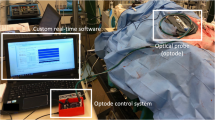Abstract
In an open interventional study the possible prospective value of fetal pulse oximetry for the detection of hypoxic risk situations of the fetus was tested in 180 cases. The saturation values during the birth were not available. Monitoring during the birth was based exclusively on CTG (cardiotocographic) traces and fetal blood analyses. The correlation between saturation values yielded by pulse oximetry and those measured in the fetal blood documents a satisfactory degree of precision for the method (r = 0.74). The good correlation between pulse oximetric saturation values and the partial pressure of oxygen documents the significance of pulse oximetry for the diagnosis of fetal oxygenation and hypoxia. It must be remarked that knowledge of the saturation values does not allow a direct estimate of the pH. Estimation of the risk of fetal acidosis requires familiarity with the course of a saturation curve based on signals of good quality and as near as possible complete signal exploitation. We calculated a sensitivity of 60%, a specificity of 79%, a positive predictive value of 27% and a negative predictive value of 95% for the occurrence of a depressed oxygen level in the child. A median saturation value below 33% was adopted as the threshold value.
Zusammenfassung
In einer offenen Interventionsstudie wurde der mögliche prospektive Wert der fetalen Pulsoximetrie für die Erkennung von hypoxischen Gefährdungssituationen des Feten in 180 Einsätzen getestet. Die Sättigungswerte waren sub partu nicht verfügbar. Die Geburtsüberwachung erfolgte allein aufgrund von CTG und Fetalblutanalysen. Die Korrelation zwischen pulsoximetrisch und nach FBA hämoximetrisch gemessenen Sättigungswerten zeigt eine zufriedenstellende Präzision der Methode (r = 0,74). Die gute Korrelation zwischen pulsoximetrischer Sättigungswerte und dem PO2 belegt die Bedeutung der Pulsoximetrie zur Diagnostik der fetalen Oxygenierung und Hypoxie. Allerdings ist durch Kenntnis der Sättigungswerte keine direkte Einschätzung des pH möglich. Erst der Verlauf der Sättigungswerte bei guter Signalqualität und möglichst lückenloser Signalausbeute erlaubt eine Einschätzung des fetalen Azidoserisikos. Es konnte eine Sensitivität von 60%, eine Spezifität von 79%, ein positiv prädiktiver Wert von 27% und ein negativer prädiktiver Wert von 95% für das Auftreten eines kindlichen Depressionszustandes berechnet werden. Dabei wurde ein Median der Sättigungswerte unter 33% als Schwellenwert angenommen.
Similar content being viewed by others
Literatur
Dildy GA, Van den Berg PP, Katz M, Clark SL, Jongsma HW, Nijhuis HW, Loucks CA (1994) Intrapartum fetal pulse oximetry: Fetal oxygen saturation trends during labour with normal neonatal outcome. Am J Obstet Gynecol 170 A: 420
Dildy GA, Clark SL, Loucks CA (1994) Intrapartum fetal pulse oximetry: The effects of maternal hyperoxia on fetal arterial oxygen saturation. Am J Obstet Gynecol 171: 1120–1124
Gardosi JO, Schram C, Symonds M (1991) Adaptation of pulse oximetry for fetal monitoring during labour. Lancet 337: 1265–1267
Gardosi JO, Damianou D, Schram CMH (1994) Artifacts in fetal pulse oximetry: Incomplete sensor-to-skin contact. Am J Obstet Gynecol 170: 1169–1173
Johnson N, Johnson VA, Bannister J, Lilford R (1991) The accuracy of pulse oxymetry in the second stage of labor. J Perinat Med 19 (4): 297–303
Luttkus A, Fengler T, Friedmann W, Dudenhausen JW (1995) Continous monitoring of fetal oxygen saturation by pulse oximetry. Obstet Gynecol 85: 183–186
Luttkus A, Fengler T, Friedmann W, Nimpsch R, Dudenhausen JW (1994) Fetale Sauerstoffsättigung bei hypoxieverdächtigem und unauffälligem Kardiotokogramm. Z Geburtsh Perinat 198: 62–66
Author information
Authors and Affiliations
Rights and permissions
About this article
Cite this article
Luttkus, A., Friedmann, W. & Dudenhausen, J. Möglichkeiten und Grenzen der Pulsoximetrie am Feten. PerinatalMedizin 9, 18–21 (1997). https://doi.org/10.1007/s001520050042
Published:
Issue Date:
DOI: https://doi.org/10.1007/s001520050042




